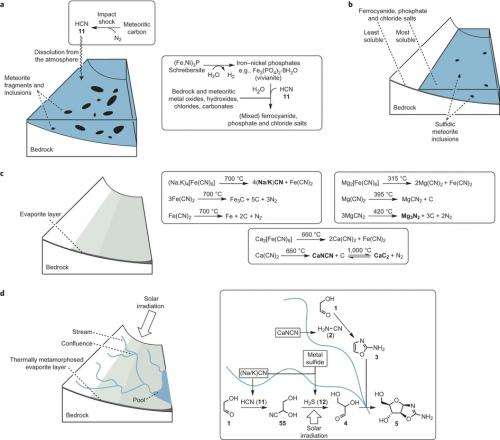March 18, 2015 report
Chemists claim to have solved riddle of how life began on Earth

(Phys.org)—A team of chemists working at the MRC Laboratory of Molecular Biology, at Cambridge in the UK believes they have solved the mystery of how it was possible for life to begin on Earth over four billion years ago. In their paper published in the journal Nature Chemistry, the team describes how they were able to map reactions that produced two and three-carbon sugars, amino acids, ribonucleotides and glycerol—the material necessary for metabolism and for creating the building blocks of proteins and ribonucleic acid molecules and also for allowing for the creation of lipids that form cell membranes.
Scientists have debated for years the various possibilities that could have led to life evolving on Earth, and the arguments have only grown more heated in recent years as many have suggested that it did not happen here it all, instead, it was brought to us from comets or some other celestial body. Most of the recent debate has found scientists in one of three chicken-or-the-egg first camps: RNA world advocates, metabolism-first supporters and those who believe that cell membranes must have developed first.
The chemists with this new effort believe they have found a way to show that all three arguments are both right and wrong—they believe they have found a way to show that everything necessary for life to evolve could have done so from just hydrogen sulfide, hydrogen cyanide and ultraviolet light and that those building blocks could have all existed at the same time—in their paper, they report that using just those three basic ingredients they were able to produce more than 50 nucleic acids—precursors to DNA and RNA molecules. They note that early meteorites carried with them ingredients that would react with nitrogen already in the atmosphere, producing a lot of hydrogen cyanide. By dissolving in water, it could have very easily come into contact with hydrogen sulfide, while being exposed to ultraviolet light from the sun. And that, they claim, would have been all that was needed to get things going.
The findings by the team are sure to garner a great deal of interest in the scientific community and others will no doubt be testing and commenting on their findings. If what they claim passes muster, their work will likely be remembered as one of the great achievements of our time.
More information: Common origins of RNA, protein and lipid precursors in a cyanosulfidic protometabolism, Nature Chemistry (2015) DOI: 10.1038/nchem.2202
Abstract
A minimal cell can be thought of as comprising informational, compartment-forming and metabolic subsystems. To imagine the abiotic assembly of such an overall system, however, places great demands on hypothetical prebiotic chemistry. The perceived differences and incompatibilities between these subsystems have led to the widely held assumption that one or other subsystem must have preceded the others. Here we experimentally investigate the validity of this assumption by examining the assembly of various biomolecular building blocks from prebiotically plausible intermediates and one-carbon feedstock molecules. We show that precursors of ribonucleotides, amino acids and lipids can all be derived by the reductive homologation of hydrogen cyanide and some of its derivatives, and thus that all the cellular subsystems could have arisen simultaneously through common chemistry. The key reaction steps are driven by ultraviolet light, use hydrogen sulfide as the reductant and can be accelerated by Cu(I)–Cu(II) photoredox cycling.
Journal information: Nature Chemistry
© 2015 Phys.org




















